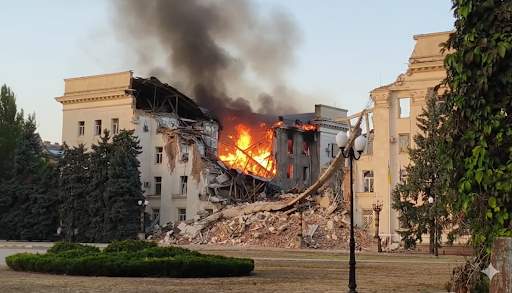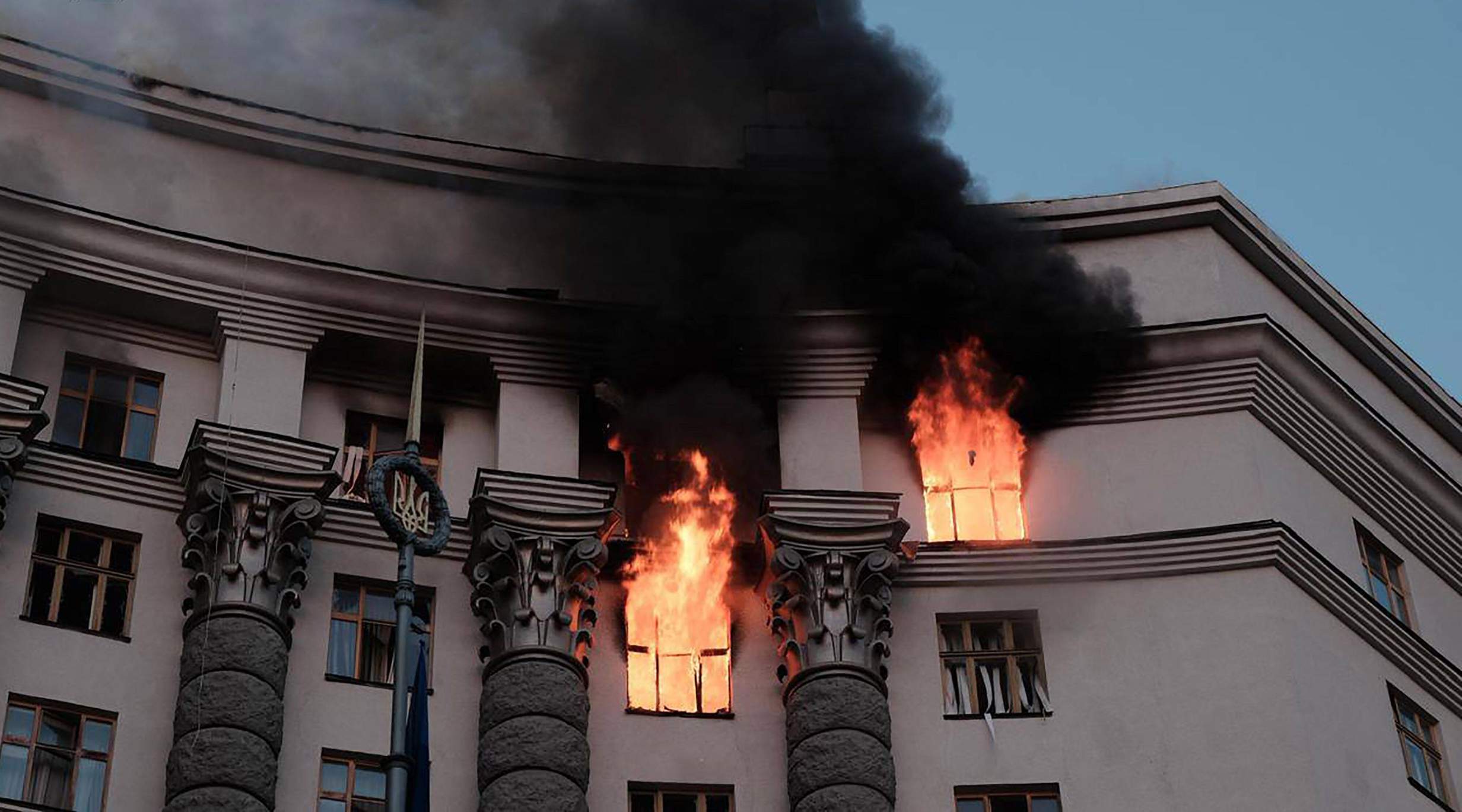
Read our Digital & Print Editions
And support our mission to provide fearless stories about and outside the media system
Russia launched a record aerial assault on Ukraine in the early hours of Sunday. 805 large strike drones and 13 missiles were launched. Ukrainian air defences intercepted 747 of the incoming projectiles. At least 11 people were killed and 75 injured across Ukraine, but rescue operations are still ongoing, and those numbers could change.
Strikes hit at least eight regions across the country and targeted multiple cities.
For the first time since February 2022, a Government building was hit in Kyiv. In the capital, five people were killed, among them a 32-year-old mother and her three-month-old son. A local resident described what happened when the missile tore through their high-rise: “A woman and a child flew out from the 6th floor, apparently through the 5th, together with the stove.”
Twenty more were injured in Kyiv. A pregnant woman wounded in the attack was forced into premature labour, giving birth to a son. Both remain in serious condition.
In Zaporizhzhia, Sumy, Kryvyi Rih, Odesa, Dnipro, civilians were killed and injured, said President Zelensky in his evening address. In Kremenchuk, a railroad bridge was destroyed. He called on allies to impose stronger sanctions and urged partners to cut Russia’s oil and gas revenues, which he said continue to finance Moscow’s “war machine.”
Ukrainian Deputy Foreign Minister Andriy Sybiga described the attacks as a “serious escalation,” stating, “Russia is intensifying its terror against Ukraine, and this requires a tough response from our allies. For the first time, over 800 drones and missiles in one night…
“The greatest cynicism is that these brutal attacks are occurring at a time when President Trump is making every effort to achieve peace. But instead of responding to these efforts and agreeing to a leaders’ meeting, Putin is rejecting diplomacy and increasing terror. Only pressure on Moscow can stop the escalation of terror. The Russian war machine is sustained by revenues from oil and gas. We call on our allies to cut off this funding in order to end the war.”
International Leaders Condemn the Attacks
President Volodymyr Zelensky emphasized the need for stronger defensive measures, stating, “Together with France, we are preparing new measures to strengthen our defences.” French President Emmanuel Macron stated, “Russia, meanwhile, is locking itself ever deeper into the logic of war and terror.”
Other European leaders also swiftly condemned the attacks. European Commission President Ursula von der Leyen remarked that once again, the Kremlin was mocking diplomacy, trampling international law and killing indiscriminately.
The head of the European Council, Antonio Costa, tweeted: “To talk about peace while bombing residential buildings shows what ‘peace’ means for Putin.”
Lithuania’s President Gitanas Nausėda called the strikes a “blatant violation of international law.” Sweden’s Prime Minister Ulf Kristersson urged the EU’s next sanctions package to more deeply target Russia’s military economy.
In the United Kingdom, Prime Minister Keir Starmer condemned the attacks as “cowardly,” stating that they showed Putin “is not serious about peace.”
In Washington, US President Donald Trump expressed readiness to impose new sanctions, stating he was “not thrilled” with Moscow’s actions and would speak to Putin “very soon.” US envoy Keith Kellogg wrote that Russia has no intention of ending the war diplomatically. The US Treasury said it is working with European allies on new sanctions, including measures targeting countries that continue to buy Russian oil.
Continued Attacks
From 22.00 on 7 September into the early hours of Monday 8 September, Russia launched another wave: 142 drones in total. Ukraine’s air force says 112 were shot down. But some reached their targets, striking energy facilities near Kyiv. The Ministry of Energy said the aim was clear: to deprive civilians of electricity, heating, and water as winter approaches. Power cuts were reported in the region. The ministry stressed that Russia’s strikes deliberately hit civilian infrastructure.
These back-to-back attacks — the first a record-breaking wave of drones and missiles, the second a direct strike on Ukraine’s energy system — mark a sharp escalation. For Ukrainians, they bring new calls for air defence and long-range strike capability. For Western partners, the question is whether condemnation and sanctions will be enough to change Moscow’s course.
Kherson Under 24/7 Terror
One region not struck during the national bombardment was Kherson—not because it was spared, but because it already endures relentless assault day and night. The regional city, located just one mile from Russian positions across the Dnipro River, has been under continuous attack. The city faces aerial bombardments, artillery fire, and tank and mortar attacks, as well as the new tactic, known as “human safari”, with FPV drones hunting civilians down in the street. In a week, 2,204 Russian drones attacked the right bank of Kherson region, of which 1,784 were destroyed by Ukrainian units, according to the Kherson Regional Military Administration.
Russian forces have deployed anti-infantry mines in residential areas, and drones have dropped incendiary mixtures, setting buildings ablaze. Electricity and gas lines have been repeatedly targeted, leaving residents without essential services. The goals of the attacks are forceful displacement.

Local officials also told of the threat of a complete “drone siege,” with drones not only attacking but also blocking the major routes and targeting aid convoys. The attacks have already severely hindered the delivery of humanitarian assistance and left civilians with limited means of escape.
Daily life in Kherson is marked by constant fear and uncertainty. Residents live under the threat of aerial and ground assaults, with hospitals overwhelmed by casualties. The city’s infrastructure is in ruins, and the population is struggling to survive amidst the ongoing siege.
These tactics in Kherson mirror the broader pattern of Russia’s recent assaults across Ukraine, where record-breaking waves of drones and missiles struck residential areas, government buildings, and critical infrastructure. Strikes on power plants, bridges, and hospitals are not incidental—they deliberately target civilian life, aiming to create chaos, fear, and disruption.
In Kherson, the combination of drone warfare, remote mining, and the destruction of homes and utilities is not a conventional military operation but a methodical campaign of terror. By cutting roads, blocking humanitarian aid, and attacking civilians directly, these actions isolate communities, degrade their ability to survive, and break the social and functional fabric of the city. In this context, Russia’s strategy constitutes terrorism: it is intended to intimidate, coerce, and demoralise the population, undermining the capacity of Ukraine’s cities to endure and resist.
ENJOYING THIS ARTICLE? HELP US TO PRODUCE MORE
Receive the monthly Byline Times newspaper and help to support fearless, independent journalism that breaks stories, shapes the agenda and holds power to account.
We’re not funded by a billionaire oligarch or an offshore hedge-fund. We rely on our readers to fund our journalism. If you like what we do, please subscribe.


